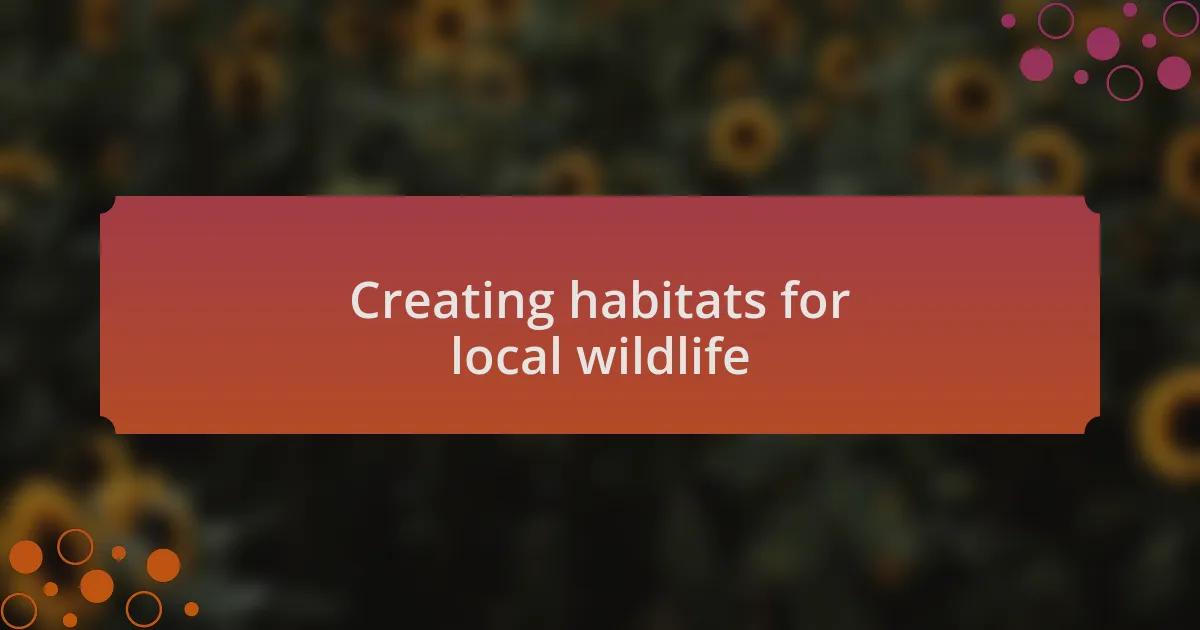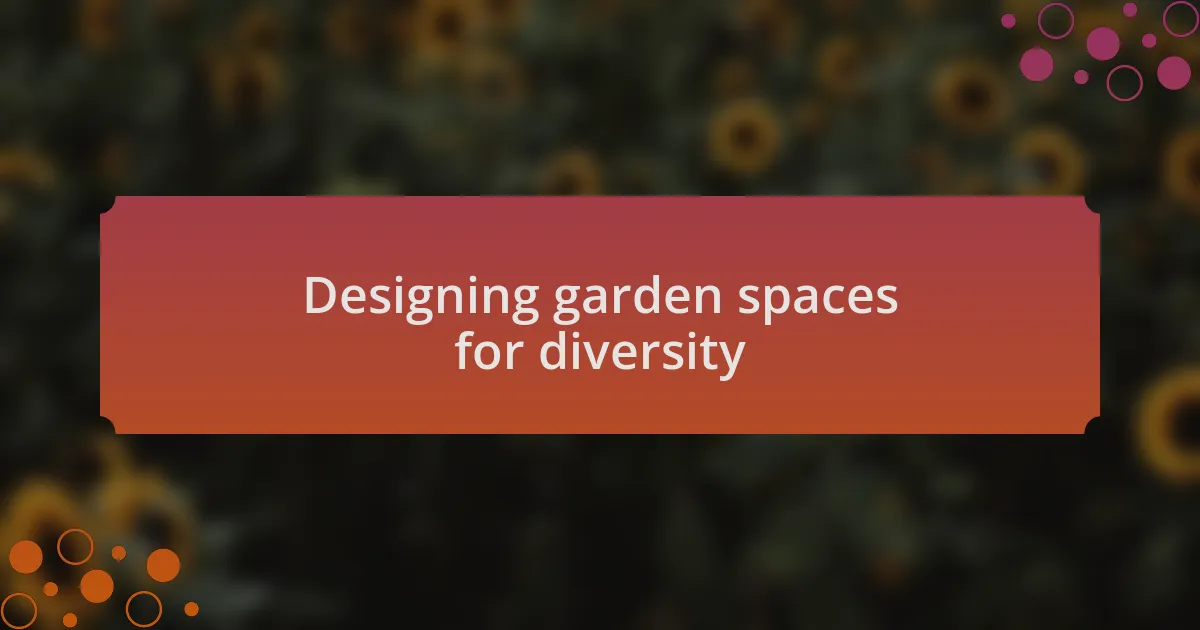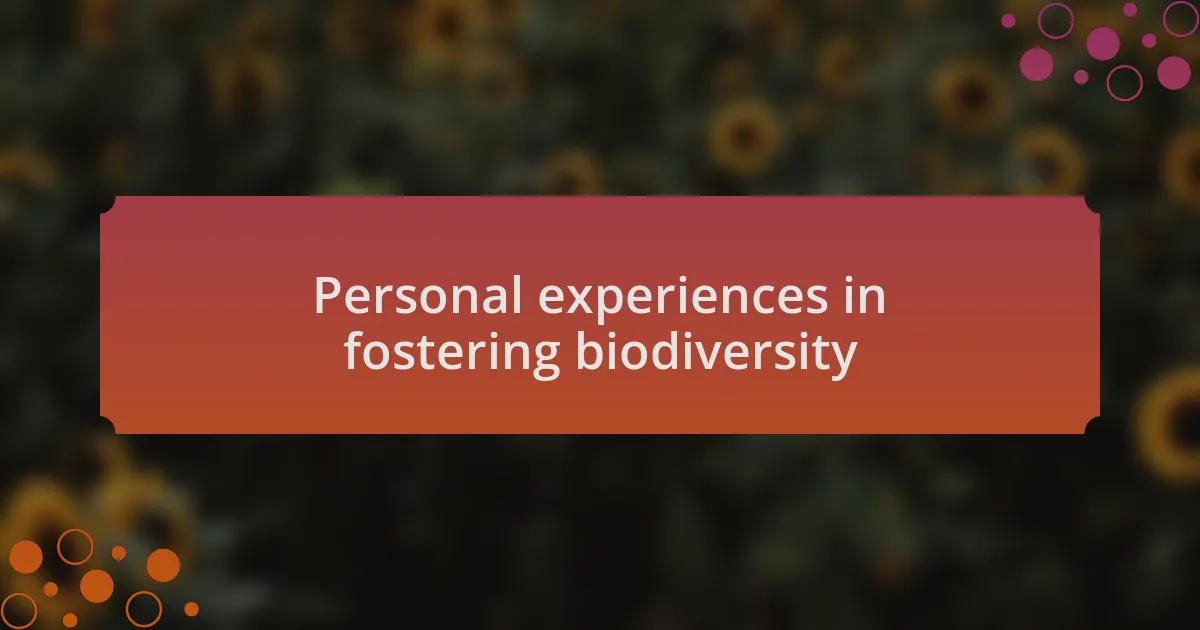Key takeaways:
- Biodiversity in landscaping creates a thriving ecosystem, enhancing wildlife interaction and ecological balance.
- Simple additions like native plants, water features, and composting can significantly boost local biodiversity.
- Designing with layers and pathways encourages diverse plant communities and surprising wildlife interactions.
- Personal experiences highlight the joy of fostering biodiversity through thoughtful gardening practices.

Understanding biodiversity in landscaping
Biodiversity in landscaping goes beyond simply planting a variety of flowers; it’s about creating a thriving ecosystem. I remember the first time I planted native species in my yard. Watching the pollinators flourish around those plants filled me with a sense of connection to nature that I had never experienced before. Have you ever felt that joy when seeing butterflies fluttering around your garden?
When we design our landscapes with biodiversity in mind, we promote ecological balance. For example, incorporating layers of vegetation—from ground cover to taller trees—can support a wider range of wildlife. I often find myself amazed by how many different bird calls I hear in my yard now compared to when I relied solely on ornamental plants. Isn’t it fascinating how a small change can invite so much life?
Understanding and fostering biodiversity means recognizing the intricate relationships between plants, animals, and the environment. When I introduced a rain garden, I noticed how it attracted beneficial insects and helped manage runoff. This simple addition not only enhanced my yard’s beauty but also offered an opportunity to give back to the environment. How might your own outdoor space thrive by embracing a more diverse planting strategy?

Creating habitats for local wildlife
Creating habitats for local wildlife can be as simple as providing the right elements. I added a few brush piles in a corner of my yard, and it transformed into a haven for small critters. Have you ever noticed how much life thrives in a seemingly untidy space? It’s remarkable to think what even a little mess can do in supporting local ecosystems.
Another effective way I foster habitats is by setting up birdhouses and feeders. Each spring, I delight in watching various species return to nest and raise their young. It’s not just about the birds, though; I’ve seen how they interact with the plants around them, establishing a lively balance that enriches my yard’s biodiversity. Isn’t it rewarding to play a role in their story?
Creating small water features can also attract a variety of wildlife. When I installed a simple pond, I was surprised by how quickly it became a gathering spot for frogs and dragonflies. The soothing sounds of water and the joy of observing these creatures up close made the effort worthwhile. Don’t you think a tiny oasis in your yard could work wonders for local wildlife?

Designing garden spaces for diversity
Designing garden spaces for diversity requires a thoughtful approach to plant selection. I vividly remember when I planted a mix of native flowers and shrubs. The transformation was incredible—suddenly, my yard was bustling with bees and butterflies. Each bloom attracted different species, and I found myself captivated by their vibrant interactions. Have you ever watched a butterfly dance from flower to flower? It’s a sight that fills me with joy and reminds me of nature’s beauty.
Another technique I’ve found effective is layering plants of varying heights. By creating a vertical garden, I invited a range of wildlife to thrive. I noticed how the taller plants provided shelter, while the shorter ones offered food sources. This strategy not only created visual interest but also enhanced the entire habitat. Isn’t it fascinating how each layer of vegetation plays a role in supporting a wider array of life?
I’ve also embraced the concept of creating pathways that meander through my garden. These winding trails not only make the space inviting but also create distinct areas for different plant communities. As I walk through these paths, I often stumble upon surprising wildlife interactions—like a group of ladybugs gathering on a cluster of herbs. This unexpected discovery highlights the beauty of diversity in garden design. Have you considered how your walking paths might encourage exploration and foster connections in your own outdoor space?

Personal experiences in fostering biodiversity
I remember the first time I set up a small pond in my backyard. At first, I was just looking for a peaceful spot to relax, but it turned into a miniature ecosystem. One evening, while sipping tea, I was thrilled to see frogs hopping on the lily pads. Their cheerful croaks filled the air, signaling that my efforts were paying off. Have you ever created a water feature that unexpectedly drew wildlife in?
One of my favorite experiences was planting a butterfly garden. I meticulously selected plants like milkweed and coneflowers, hoping to attract specific species. To my surprise, within weeks, I noticed various butterflies fluttering about, each with its own unique pattern. It was like hosting a charming parade. I couldn’t help but feel a sense of pride in cultivating an environment that welcomed such beauty. How rewarding is it to witness your garden become a sanctuary for these delicate creatures?
Another memorable aspect was making space for composting. Initially, it felt like an extra chore, but over time, my compost became a rich resource for nourishing the plants. Seeing the diversity of worms and microbes working together made me appreciate the hidden life thriving beneath the surface. Have you ever thought about how something as simple as composting can contribute to a vibrant garden ecosystem?